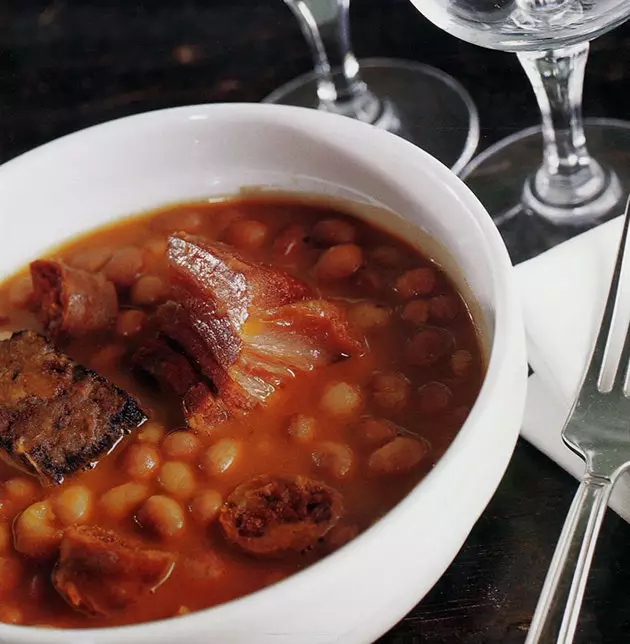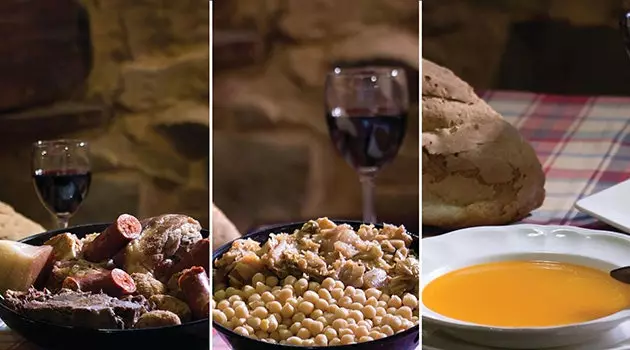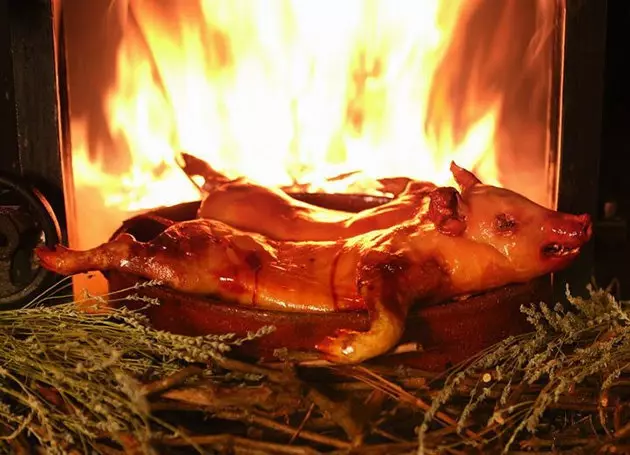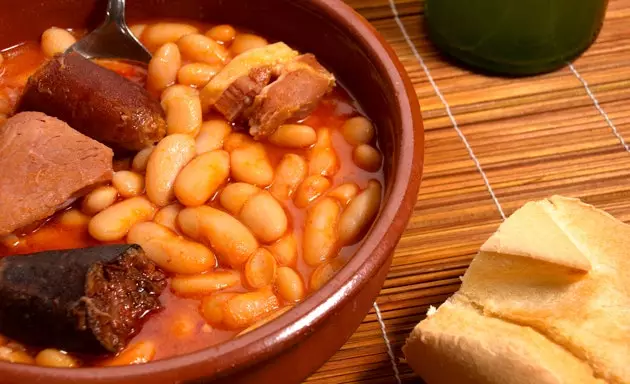
Red beans with shells
We have it clear but not everyone is convinced by the palate. To make your work easier, we have selected ten corners of Spain that they will love to visit and where you can also give yourself that gastronomic tribute. So waiting for the arrival of summer will be much more bearable.
LAMB IN PEÑAFIEL
Going up to the Castle of this town located in the heart of Ribera del Duero is the excuse to eat a good suckling lamb Peñafiel (Valladolid) is one of the most famous towns in Castilla y León for this dish. Its large wood-fired ovens roast suckling pigs of the churra breed weighing between 5 and 6 kilos that arrive at the table with crispy skin and tender meat . Only one company is possible: the romaine lettuce and tomato salad and a bottle of Ribera de Duero. In terms of bread, the Castilian candeal is a good option, but the oil cake is even better.
But not only do you have to see the castle from the inside, the bullring square It offers a curious perspective of this fortress built in the 10th century and which today preserves the appearance it acquired after the reforms of the 14th and 15th centuries. The excursion cannot end there. Since we are in the land of wine and wineries, why not pay a visit to one of the ones in the area?
DUELS AND BREACHES IN ALMAGRO
You don't have to wait for July to visit Almagro (Ciudad Real) and see its famous Corral de Comedias in operation. In addition, summer is not the time to taste the Manchego delicacies that Don Quixote de la Mancha spoke so much about. Almagro is famous for its aubergines, perfect for an aperitif. But if we want to get warm we should ask 'Duels and losses' , a dish made with scrambled egg, chorizo and streaky pork bacon which is prepared in the frying pan and served in a clay pot. You don't have to be very smart to guess that it has a high caloric content, so it wouldn't be a bad idea to take advantage of the afternoon to walk around the town. The main square, the Convent of the Asunción de Calatrava and the Almacén de los Fúcares are three of the sites that we cannot miss.
COOKED MARAGATO IN CASTRILLO DE LOS POLVAZARES
Its red stone constructions give this town in the Maragatería region a unique appearance, which in winter exudes cold and silence. In **Castrillo de los Polvazares (León)** it seems that the years have not passed and walking down its Calle Real is like moving to another era. Even in eating they preserve the customs of yesteryear. The cocido maragato, as the dish prepared in the area is called, you eat it the other way around: first you eat the meat, then the vegetables, and finish with the soup . It has an explanation: the maragatos were muleteers who on their trips through Spain carried food in a lunch box. When they arrived at the inns, they ate the cold meat and crowned the menu with a hot soup or broth that they asked the innkeeper to warm up the body.
Castrillo is only five kilometers from Astorga . There is no excuse not to go to this town where the seat of one of the oldest dioceses in Spain is located and see its Episcopal Palace, one of the only two works that Gaudí made outside of Catalonia.

Cooked maragato at Entrepiedras restaurant
CAPARRONES FROM EZCARAY
There are many reasons to get to know Ezcaray (La Rioja), from visiting the Gothic church of Santa María la Mayor or enjoying a beer in the Plaza del Conde de Torremúzquiz (also called Plaza del Kiosco) to deciding to do one of the hiking trails that start from this town and run through the Oja Valley. One of them (17 kilometers long) leads to San Millan de la Cogolla , where the well-known monastery of San Millán is located.
But if there is a gastronomic reason to visit this point, it is its pinto caparrones. These garnet-colored beans are common in this area of La Rioja and are served accompanied by their 'sacraments'. These are meats from the autochthonous slaughter such as chorizo, bacon, black pudding, pig's ear, marinated pork rib and sometimes cabbage . Who said cold?
SUCKLING PIG IN PEDRAZA
The location chosen by Pablo Berger to shoot the latest Christmas lottery ad (yes, the one for Montserrat Caballé and Raphael) and where the director set several of the scenes of his 'Snow White' is full of places that we should not miss. Even if we didn't have the incentive to go eat suckling pig. The Plaza Mayor, which preserves the mansions and palaces of the 16th and 17th centuries, It is for many one of the most beautiful in Spain . In Pedraza you can also see what the dungeons were like in the 13th century prisons and you can visit the medieval castle, completely restored and which today houses the Ignacio Zuloaga museum. It is a town from another time and that is why series such as Toledo, Tierra de Lobos, Isabel or Águila Roja have been filmed here.
There are plenty of reasons to visit it and eat a roast suckling pig. The most characteristic dish of Segovian gastronomy is eaten as suckling lamb: just accompany it with a salad and a good wine . And if you still have room you can order punch for dessert. 'Tomorrow will be another day'.

The mythical suckling pig of José María, in Segovia capital
MOUNTAIN COOKED IN VEGA DE PAS
In Vega de Pas (Cantabria) it seems that time has stopped. Here, even the town square, with glass houses and slate roofs, is a quiet place. But where we will find true calm is on the outskirts. There are calls Pasiegas cabins, houses from another era where ranchers and small farmers live , in some of which there is neither electricity nor running water.
The tradition is also transferred to the plate in Vega de Pas. This municipality is the cradle of the mountain stew, a typical Cantabrian dish whose recipe differs from other stews eaten in Spain. Here no chickpeas . The plate is composed of cabbage and white beans accompanied by bacon, chorizo, ribs and black pudding.
FABADA IN PROAZA
The interior of Asturias hides interesting secrets for outsiders. Because if the coast is known by all, places like Proaza are still a mystery . This town of less than 800 inhabitants is located in the middle of the Bear Path, a path of almost 35 kilometers that runs through where the mining train used to pass through the valley of the Trubia River. The route can be traveled on foot or by bicycle, but we must never lose sight of the surroundings. The most famous greenway in Asturias offers the possibility of seeing a brown bear up close. The journey should finish with a good fabada although without forgetting to leave room for dessert. Outside of Asturias you will not find such a good rice pudding.

Fabada: the must of the Asturian stove
RICE WITH CHICKPEAS AND HANDS OF LAMB IN CARAVACA DE LA CRUZ
If in summer we go to Valencia to eat paella, in winter we should go down a little further and visit the Murcian mountains to try rice with chickpeas and lamb hands . This winter recipe is prepared with rice from Calasparra, the first in the world with designation of origin.
The best excuse to try it is to pay a visit to Caravaca de la Cruz. This Murcian municipality has been considered since 1998 as one of the five holy cities (the others are Jerusalem, Rome, Santiago de Compostela and Camaleño). Pilgrims arrive in Caravaca to visit the Basilica-Sanctuary of La Santísima y Vera Cruz, a Baroque work that stands next to the walls that protected the place in the XV. But neither can we leave aside the pagan . Strolling through its old town of medieval origin is another good reason to come here.
SENIOR PORK CIVET IN MAÇANET DE CABRENYS
To make a real trip to the past, you have to visit Maçanet de Cabrenys, in the Alt Empordà region of Girona. This town of less than 1,000 inhabitants was already occupied during prehistory. It is shown by the presence of Dona Morta and Pedra Dreta menhirs . They are two of the points that we should visit if we decide to make this getaway whose real objective would be to try the civet de porc senglar (or wild boar stew) .
This recipe, as typical as it is forceful, can be eaten both in autumn and in winter. The business period for wild boar hunting in Girona ends on March 30 and that is when this dish disappears from the menu. They can also be ordered 'pomes de relleno', which are prepared with minced pork and that are considered one of the oldest dishes of Catalan cuisine.
CRUMBS IN GUADALUPE
Twenty years ago the Royal Monastery of Santa María de Gualalupe (Cáceres) was declared a World Heritage Site by UNESCO. This is the main reason why we should make a trip to this town, although not the only one. Guadalupe is also famous for its old town, which dates back to the 15th and 16th centuries.
We cannot travel to Guadeloupe in winter and stay without trying the migas extremeñas . This dish emerged as a food for shepherds and today it is a benchmark in the gastronomy of the center and south of the peninsula. made with stale bread, oil and garlic are accompanied by bacon, chorizo, bacon and peppers . Eating them surely won't go cold and we won't be hungry either, but since we are in Guadeloupe we should leave a place for dessert. Conventual sweets abound here, such as perrunillas, buñuelos de viento, pestiños, hornazos and mantecados. Impossible to resist.
